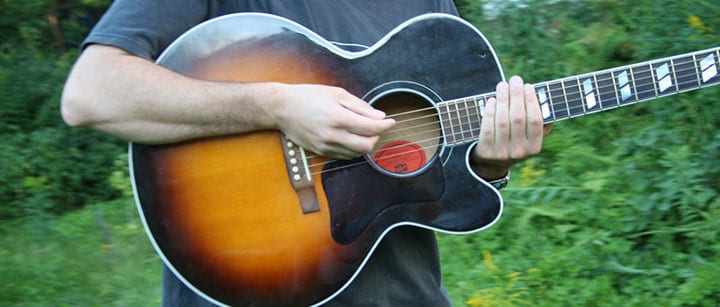Chord changes tripping you up? Here, Brooklyn, NY teacher Jef B. shares his secret for the easy way to learn those tricky guitar chord transitions…
“Gaah! I want more fluidity while playing Stairway to Heaven, but there are so many chords and the song is so long and I can’t switch between them well and…!!”
Sound familiar?
When I was first learning to play guitar, I didn’t realize how much something as simple as switching from one chord to another would help me overcome other challenges I faced in my daily life. It’s true, and learning guitar is a great way to overcome any challenge. Chords are like little mini challenges that support the songs of life. Once they become fluid you will be skipping merrily along from one place to the next.
Like most people, I struggled with being fluid when changing chords on the guitar. I felt at times that I would never be able to achieve what I saw professional guitarists do with such ease. It’s a bit like when I used to draw: one day I realized I couldn’t draw like Michelangelo, so I stopped! But all I really needed was some encouragement, guidance, and, well, some drawing lessons!
I recently took saxophone lessons with a great teacher and was reminded of something crucial when it comes to fluidity: it’s about taking baby steps. My teacher suggested that I practice my scales at the rate of my heartbeat (60 BPM). No faster, until it’s perfect. It’s funny because I hadn’t thought this way before on the horn, yet here is what I teach on guitar about being fluid with your chords. It’s remarkably similar.
So you are having difficulty switching from the G chord to the D7 chord. Anybody would at first. The shapes are so different from one another. Here’s my advice for the easy way to learn guitar chord transitions:
Step 1: Get your picking (or strumming!) hand outta there. It wants to help out, but right now it is getting in the way, so put it behind your back. Forget that it exists if you can! Or tell it to take a coffee break because it’s been working so hard…
Step 2: Slowly switch back and forth between the two chords that are challenging you with your fretting hand only. Breathe and relax. Try to notice how little your fingers actually need to move. I emphasize slowly; there is no rush. It’s easy to get into the mindset that there is some pressure on you, or maybe you feel the need to impress your teacher. Let those notions go! You are learning guitar because you want to play! Do this slowly until it feels like habit to build up your muscle memory. It will eventually become effortless, like having a conversation over tea about something you love.
Step 3: Add your strumming hand back into the mix. Don’t forget to breathe! Strum as slowly as you need until it takes no effort. Great music is relaxed no matter how intense a song is.
Step 4: Take a little break to absorb what you have just achieved. Think of it as a celebration. Celebrating helps me face the next challenge with ease.
Step 5: REPEAT 1-4 on your next challenging chord change.
It’s taking these little bite-sized steps that will get you there, just like learning anything else. Break it down and practice the little things SLOWLY. Those little things add up quickly and before you know it, you’ll be a chord master!
I also encourage you to play with other people as often as you can. We have a way of leading each other when we work together, much like dancing. Be amazed at what you can do!
 Jef B. teaches bass guitar, guitar, and saxophone lessons in Brooklyn, NY. He currently plays in a jazz band called Gospel Of Mars, and recently started a project called Gardens that leans heavily toward trip hop and psychedelic. Learn more about Jef here!
Jef B. teaches bass guitar, guitar, and saxophone lessons in Brooklyn, NY. He currently plays in a jazz band called Gospel Of Mars, and recently started a project called Gardens that leans heavily toward trip hop and psychedelic. Learn more about Jef here!
Photo by wmshc_kiwi
Suzy S.


